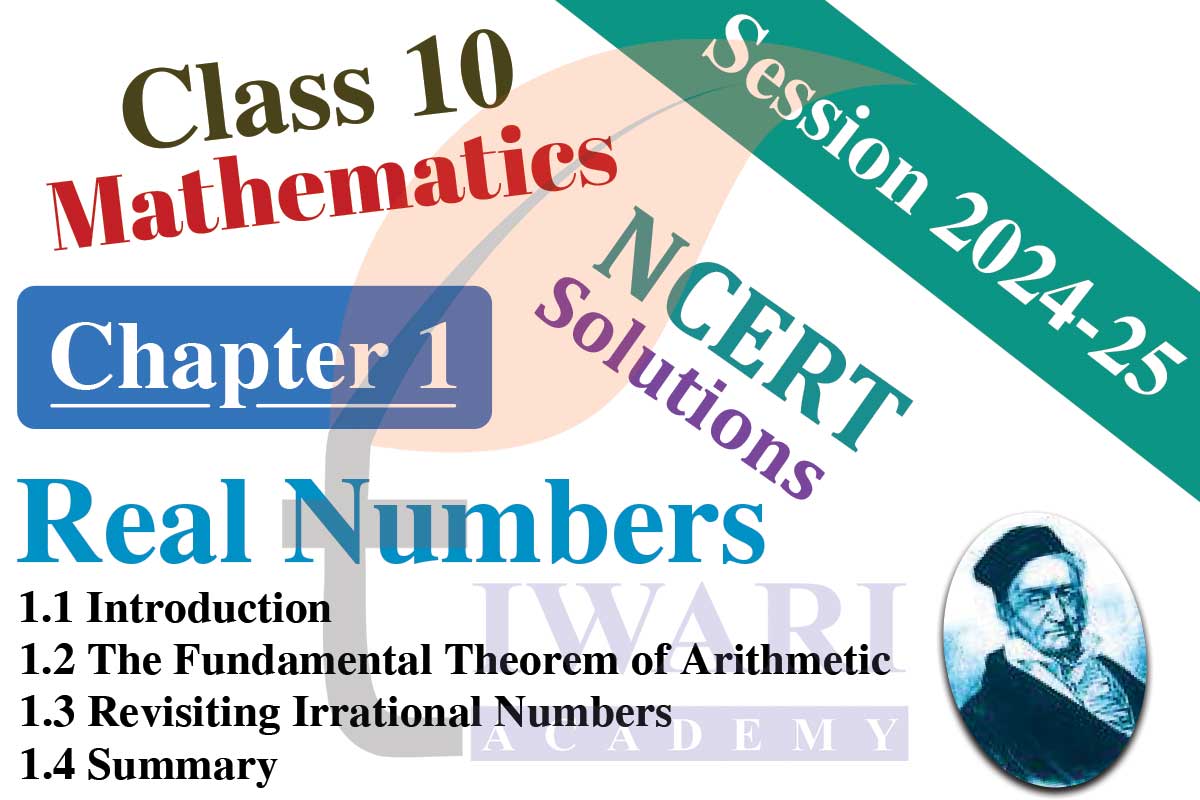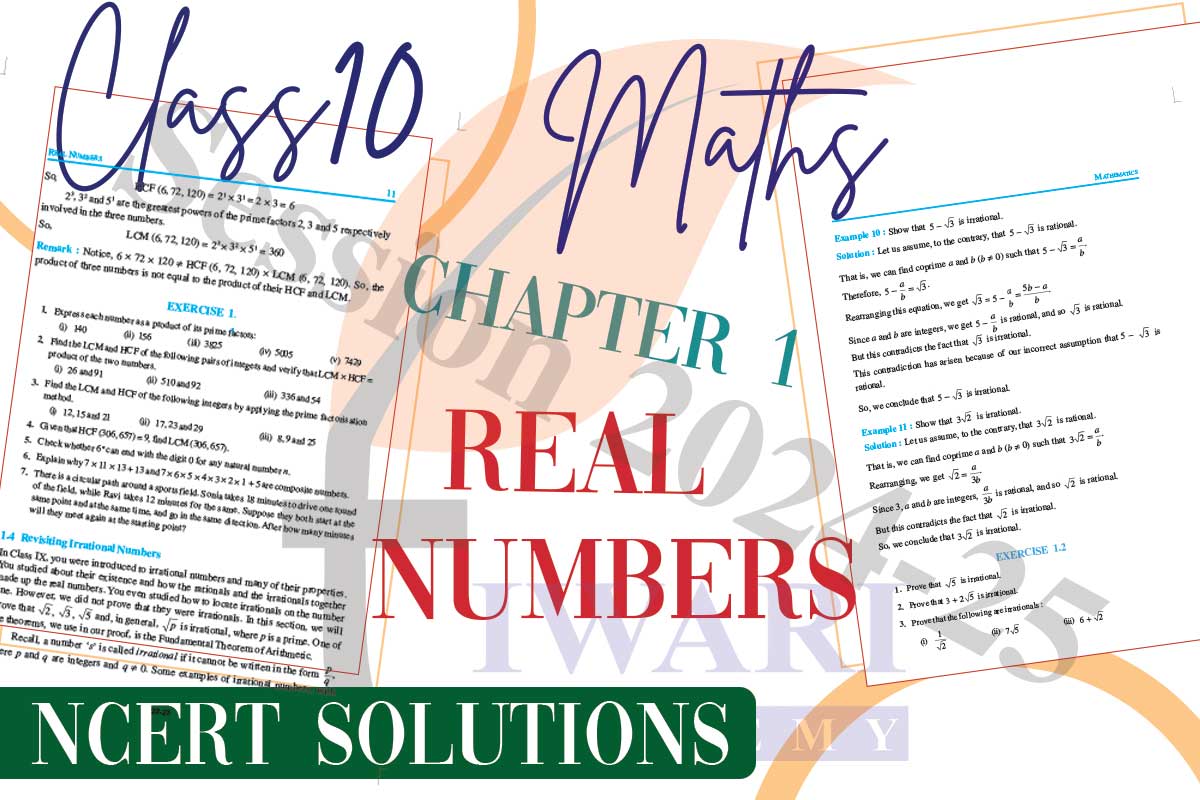Class 10 Maths Chapter 1 Solutions
Class 10 Maths Chapter 1 Main Topics
Class 10 Maths Chapter 1 Practice Tests
10th Maths Chapter 1 Question wise Solutions
Class 10 Maths Chapter 1 MCQ
Class 10 Maths Chapter 1 Assignments
NCERT Solutions for Class 10 Maths Chapter 1
Learning Class 10 Maths Chapter 1, Real Numbers, effectively requires a systematic approach and a clear understanding of the concepts involved. Here are some steps and strategies to help you learn this chapter.
Get here the NCERT Solutions for Class 10 Maths Chapter 1 Real Numbers all exercises in Hindi and English medium revised and modified for session 2024-25. The solution of chapter 1 class 10th mathematics is updated according to NCERT textbooks published for 2024-25 CBSE exams.
Euclid’s Division Lemma states that for any two positive integers a and b, there exist unique integers q and r such that: a = bq + r, where 0 ≤ r < b.
The Fundamental Theorem of Arithmetic states that every positive integer greater than 1 can be expressed as a product of prime numbers in a unique way, up to the order of factors.
| Class: 10 | Mathematics |
| Chapter: 1 | Real Numbers |
| Number of Exercises: | 2 (Only Two) |
| Content: | NCERT Exercises Solutions and Tests |
| Academic Session: | Year 2024-25 |
| Medium: | Hindi and English Medium |
Methods for proving the irrationality of certain numbers, such as the square root of a prime number, are discussed. Understanding decimal expansions of real numbers. Terminating decimals and recurring decimals. Rationalization is the process of converting an irrational number into a rational one by multiplying or dividing by a suitable number.

According to rationalised syllabus for academic session 2024-25, only two exercises are in chapter 1. The exercise 1.1 deleted and exercise 1.2 become the exercise 1.1. Similarly exercise 1.3 become exercise 1.2 and exercises 1.4 is also deleted.
The course structure of class 10 mathematics chapter 1 is given below:
Fundamental Theorem of Arithmetic – statements after reviewing work done earlier and
after illustrating and motivating through examples, Proofs of irrationality of √2, √3, √5.
>> Total Number of Exercises: 2
>> Total Marks in Board Exam: 6
>> Number of Periods needed: 15
Class 10 Maths Chapter 1, titled Real Numbers, is an important chapter that lays the foundation for understanding various mathematical concepts. The main points covered in this chapter include introduction to Real Numbers. Real numbers are a set of numbers that includes all rational and irrational numbers. Real numbers can be represented on the number line.
Utilize online resources like video tutorials, educational websites like Tiwari Academy, and interactive quizzes to reinforce your understanding of the chapter. As you progress, practice solving sample papers or past year question papers. This will help you become familiar with the exam pattern and time management. Periodically test your knowledge by attempting self-assessment quizzes or problems from the chapter. This will help you gauge your progress.
In class 10 Maths Chapter we will learn about understanding square numbers and their properties. Finding the square root of a number using prime factorization. Real numbers are used in various mathematical applications, such as finding the distance between two points in coordinate geometry.
Class 10 Maths Chapter 1 Real Numbers
The chapter provides numerous examples and practice problems to reinforce the concepts discussed. These are the main points covered in Class 10 Maths Chapter 1, Real Numbers. It serves as the building block for further mathematical concepts and is essential for a solid foundation in mathematics. Get here topic wise NCERT Solutions for 10th Mathematics chapter 1 all exercises in Hindi and English medium. Students can take help of videos for solving questions of each exercise.
Class 10 Maths Chapter 1 Solutions for CBSE Board
Class 10 Maths Chapter 1 Solutions for State Boards
10th Maths Chapter 1 Exercise 1.1 Solutions
Class 10 Maths Chapter 1 Exercise 1.1 Question 1
Express each number as a product of its prime factors: (i) 140 (ii) 156 (iii) 3825 (iv) 5005 (v) 7429
The step by step solutions of each part is given here with practice questions>. You can discuss with us Part (i), Part (ii), Part (iii), Part (iv), and Part (v) to learn more about the solution.
Class 10 Maths Chapter 1 Exercise 1.1 Question 2
Find the LCM and HCF of the following pairs of integers and verify that LCM × HCF = product of the two numbers. (i) 26 and 91 (ii) 510 and 92 (iii) 336 and 54.
Get the solution of question 2 and discuss Part (i), Part (ii) and Part (iii) with us along with assignments and other doubts for more clarification.
Class 10 Maths Chapter 1 Exercise 1.1 Question 3
Find the LCM and HCF of the following integers by applying the prime factorisation method. (i) 12, 15 and 21 (ii) 17, 23 and 29 (iii) 8, 9 and 25.
Discuss with part one, two and three in detail and get worksheets to understand the solution in simple way.
Class 10 Maths Chapter 1 Exercise 1.1 Question 4
Given that HCF (306, 657) = 9, find LCM (306, 657).
The solution of this question is very simple and usually asked in MCQ type questions. For more revision, please write to us.
Class 10 Maths Chapter 1 Exercise 1.1 Question 5
Check whether 6ⁿ can end with the digit 0 for any natural number n.
The solution of question 5 is similar to the example given in textbook. Discuss with us and Practice here more questions based on question 5.
Class 10 Maths Chapter 1 Exercise 1.1 Question 6
Explain why 7 × 11 × 13 + 13 and 7 × 6 × 5 × 4 × 3 × 2 × 1 + 5 are composite numbers.
Extra questions for practice based on the solution of question 6 are given here to download. Put your view to discuss with us.
Class 10 Maths Chapter 1 Exercise 1.1 Question 7
There is a circular path around a sports field. Sonia takes 18 minutes to drive one round of the field, while Ravi takes 12 minutes for the same. Suppose they both start at the same point and at the same time, and go in the same direction. After how many minutes will they meet again at the starting point?
Question number 7 is important for exams. Get here practice assignments with answers for revision.
10th Maths Chapter 1 Exercise 1.2 Solutions
Class 10 Maths Chapter 1 Exercise 1.2 Question 1
Prove that √5 is irrational.
To understand the solution of question 1, student need to practice assignments and discuss the explanation in depth.
Class 10 Maths Chapter 1 Exercise 1.2 Question 2
Prove that 3 + 2√5 is irrational.
Get here the assignments and practice questions based on the solution of question 2. If still there is any doubt, please visit to discussion forum.
Class 10 Maths Chapter 1 Exercise 1.2 Question 3
Prove that the following are irrationals: (i) 1/√2 (ii) 7√5 (iii) 6 + √2
The solution of question 3 is similar to question 1 and 2. Get more practice to learn the concepts in better way. Discuss in detail here.
Use number lines and diagrams to visualize concepts like decimal expansions and the placement of real numbers on the number line. Visual aids can help make abstract concepts more concrete. Don’t hesitate to ask your teacher or a classmate for help if you encounter difficulties. Sometimes, discussing problems with others can provide valuable insights. Maintain a study schedule and allocate specific time slots for learning and practicing this chapter. Consistency is key.
The complete chapter of 10th Maths chapter 1 is divided in four main parts. The explanation of each part with video explanation is given below. Start by reading the chapter thoroughly and grasp the basic definitions and concepts. Ensure that you understand the definitions of real numbers, Euclid’s Division Lemma, and the Fundamental Theorem of Arithmetic. Take concise notes while reading the chapter. Write down key formulas, definitions, and important points. These notes will be helpful for quick revision.
Learn here how to find the prime factorization of numbers. This skill is essential for various aspects of number theory. Practice finding the prime factorization of different numbers. Practice working with terminating and recurring decimals. Solve problems that involve decimal expansions of real numbers. Familiarize yourself with methods for rationalizing irrational numbers, especially square roots. Practice these techniques with different examples. Remember that learning mathematics often requires patience and persistence. Take your time to understand each concept thoroughly before moving on to the next. By following these steps and strategies, you can effectively learn Class 10 Maths Chapter 1 Real Numbers.
Class 10 Maths Chapter 1 Main Topics
Mathematics is best learned through practice. Solve a variety of problems related to real numbers, including examples from your textbook and additional practice questions. Pay attention to different types of questions, such as finding HCF, LCM, prime factorization, and working with decimal expansions.
| Topics | Detail about the Topics |
|---|---|
| Topic: 1 | Euclid’s Division Lemma |
| Topic: 2 | The Fundamental Theorem of Arithmetic |
| Topic: 3 | Dealing with Irrational with Square Root |
| Topic: 4 | Decimal Representation of Rational Numbers |
10th Maths Chapter 1 Practice Test Papers
Euclid’s Division Lemma is a fundamental concept in this chapter. Make sure you understand how it works and can apply it to solve problems related to divisibility and remainders. There are four exercises in chapter 1 covering all the four topics on Real Numbers. Students can practice well using the 6 question papers given below. It will help to prepare the chapter for CBSE exams also.
Class 10 Maths Chapter 1 Practice Tests with Answers

Historical Facts on Real Numbers
The word algorithm come from the name of the name of the 9th century Persian mathematician al-Khwarizmi. The word ‘algebra’ is derived from a book, he wrote, called Hisab al-jabr w’al-muqabala.
An equivalent version of Fundamental theorem of Arithmetic was probably first recorded as Proposition 14 of Book IX in Euclid’s Elements, before it came to be known as the Fundamental Theorem of Arithmetic.
However, the first correct proof was given by Carl Friedrich Gauss in his al-Khwarizmi.
Carl Friedrich Gauss is often referred to as the ‘Prince of Mathematicians’ and is considered one of the three greatest mathematicians of all time, along with Archimedes and Newton. He has made fundamental contributions to both mathematics and science. Learn here how to make class 10 Maths chapter 1 easy to learn.
How many exercises are there in class 10 Maths chapter 1 Real numbers?
Now there are only 2 exercises in class 10 chapter 1 (Real numbers):
In first exercise (Ex 1.1), there are 5 questions.
In second exercise (Ex 1.2), there are 7 questions.
So, there are in all 18 questions in class 10 chapter 1 (Real numbers).
There are in all 11 examples in class 10 chapter 1 (Real numbers).
- Examples 1,2,3,4 are based on Ex 1.1.
- Examples 5,6,7,8 are based on Ex 1.2.
Are there any Theorems or Algorithm in 10th Maths chapter 1?
Yes, there are 7 Theorems and 1 Algorithm in class 10 chapter 1 (Real numbers).
First exercise (Ex 1.1) is based on Theorem 1.1 (Euclid’s Division Lemma) and Euclid’s Division algorithm.
Theorem 1.2 (Fundamental Theorem of Arithmetic) is used in second exercise (Ex 1.2).
What are the Important questions from Maths class 10 chapter 1 Real numbers?
Important questions from Maths class 10 chapter 1:
- In first exercise (Ex 1.1), all questions are important.
- In second exercise (Ex 1.2), Q2, 4, 5, 7 are important.
Which topics students should recall before starting class 10 Maths chapter 1?
Students should recall some topics of class 9 chapter 1 (Number systems).
Topics:
- Types of numbers (Natural number, Whole number, Integers, Rational numbers, Irrational numbers and Real numbers).
- Decimal expansion of Rational numbers (Terminating and Non-terminating recurring) and Irrational numbers (Non-terminating non-recurring).
- HCF (Highest Common Factor) and LCM (Lowest/Least Common Multiple).
- And some other topics like Meaning of Dividend, Divisor, Quotient and Remainder, Prime numbers, Composite numbers, Factors.





